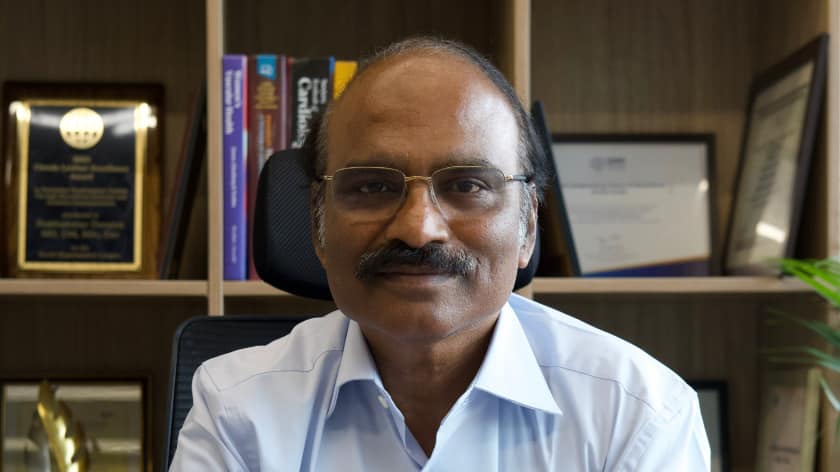Chronic diseases now cause 2/3 of deaths in India, striking people in their peak years and costing trillions. Ahead of its 25th anniversary, CCDC highlights urgent action on NCDs—through policy, innovation & public participation—to secure a healthier India by 2047.

Prof. (Dr) Dorairaj Prabhakaran, cardiologist, epidemiologist, and executive director of CCDC
Shahid Akhter, Consulting Editor, FEHealthcare, spoke to Prof. (Dr) Dorairaj Prabhakaran, cardiologist, epidemiologist, and executive director of CCDC, on the rising burden of NCDs—diabetes, heart disease, cancer, and lung disorders—which have overtaken infections as India’s leading killers, their impact, and the way forward.
How significant is the burden of chronic diseases in India?
Chronic conditions, also known as non-communicable diseases (NCDs), now account for nearly two-thirds of all deaths in the country. In India, more than half of NCD deaths occur before people turn 70, while in the West, most NCD deaths happen after that age. These are the peak years of one’s life. When young breadwinners die prematurely, the loss is not only personal but also economic.
A Harvard study estimates that by 2030, India could lose as much as $3 trillion in economic output due to chronic diseases—equivalent to the current size of its economy. The impact is felt hardest by lower-middle-class families, who often fall back into poverty when the primary earner is struck by illness or death. In most cases, children, especially girls, are pulled out of school to support households suddenly deprived of income.
How has India’s disease burden shifted over the decades?
India’s story is an example of this shift. In 1990, communicable diseases were the leading killers. Three decades later, NCDs dominate across every Indian state, whether developed or underdeveloped. “This transformation has been dramatic and worrying,” said Dr. Prabhakaran.
In 1990, communicable diseases were the leading killers in India. Three decades later, NCDs dominate across every state, whether developed or underdeveloped. This transformation has been severe and worrying.
What progress has been made through policies and health programs?
Recognizing the looming crisis, global efforts to curb NCDs gained momentum in the late 1990s. A watershed moment came in 2004 with the Framework Convention for Tobacco Control, which provided guidelines for reducing tobacco use worldwide. Similar frameworks have since targeted alcohol consumption, salt reduction in processed foods, and eliminating harmful trans fats.
India, too, has made progress. The government’s national program for non-communicable diseases now includes policies for team-based care, task-shifting to trained non-physician providers, and electronic decision support systems to better manage hypertension and diabetes—the two most prevalent risk factors.
Despite cheap and effective medicines, only about 20% of urban patients and 10% of rural patients with hypertension have their blood pressure under control. To solve this, we need systemic redesign. If patients are given medicines for longer durations at a time, they won't have to make frequent visits to refill prescriptions. In addition, telemedicine consultations and technology-driven care delivery can make a difference.
Beyond health systems, what environmental challenges worsen the problem?
Health systems alone cannot solve the crisis. The environment in which people live plays a crucial role. Take physical activity: doctors routinely prescribe 30 minutes of brisk walking daily. Yet in many Indian cities, safe spaces for walking are rare, footpaths are encroached upon, and women may avoid parks for safety reasons.
Air pollution is another serious concern. From crop burning in Punjab and Haryana to vehicular emissions and industrial pollution, India’s toxic air has been directly linked to hypertension and diabetes in recent studies. Air pollution is now recognized as a major risk factor, yet action has been limited and piecemeal.
What role has the Centre for Chronic Disease Control (CCDC) played in tackling NCDs?
The Centre for Chronic Disease Control, founded in 2000 under the leadership of Prof. K. Srinath Reddy, has been at the forefront of chronic disease research and policy advocacy in India. What began as a modest initiative has grown into a hub of large-scale research, policy interventions, and capacity building.
Over the years, CCDC has focused on three core areas:
Understanding disease mechanisms: Through longitudinal studies involving over 20,000 people in Delhi and Chennai, CCDC has explored why Indians are more prone to diabetes and heart disease than Western populations. Notably, its research was among the first to establish links between air pollution and metabolic disorders in India.
Innovating low-cost solutions: From experimenting with yoga-based cardiac rehabilitation to deploying telemedicine platforms, CCDC has sought ways to make chronic disease management affordable and scalable. Its team-based care model is now recognized as a best practice under India’s national NCD program.
Building capacity: Training doctors and primary care physicians, advancing research in environmental and digital health, and fostering collaborations with institutions such as AIIMS, Imperial College London, and Emory University are central to its mission.
How is CCDC marking its 25th anniversary, and what lies ahead?
This year, CCDC marks its 25th anniversary with a major symposium in New Delhi on September 18–19. The event will bring together over 300 experts from India and abroad, including eminent names.
The symposium will cover themes ranging from environmental health and digital solutions to worksite interventions and ethical research practices. We want to use this milestone to shape a roadmap for India’s health in 2047, when the nation aspires to become a developed country.
While the challenges are daunting, the solutions are close at hand. Creating safe environments for exercise, reducing pollution, improving access to healthy food, and reimagining healthcare delivery are all achievable with the right mix of policy, innovation, and public participation. As we move towards India@100, health must be central to the vision. We have the evidence, and we know the risks. The question now is, do we have the will to act?
Empower your business. Get practical tips, market insights, and growth strategies delivered to your inbox
By continuing you agree to our Privacy Policy & Terms & Conditions
